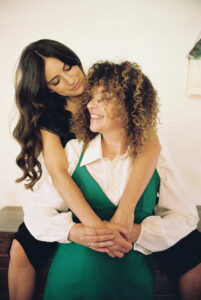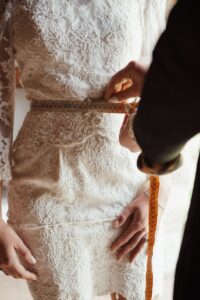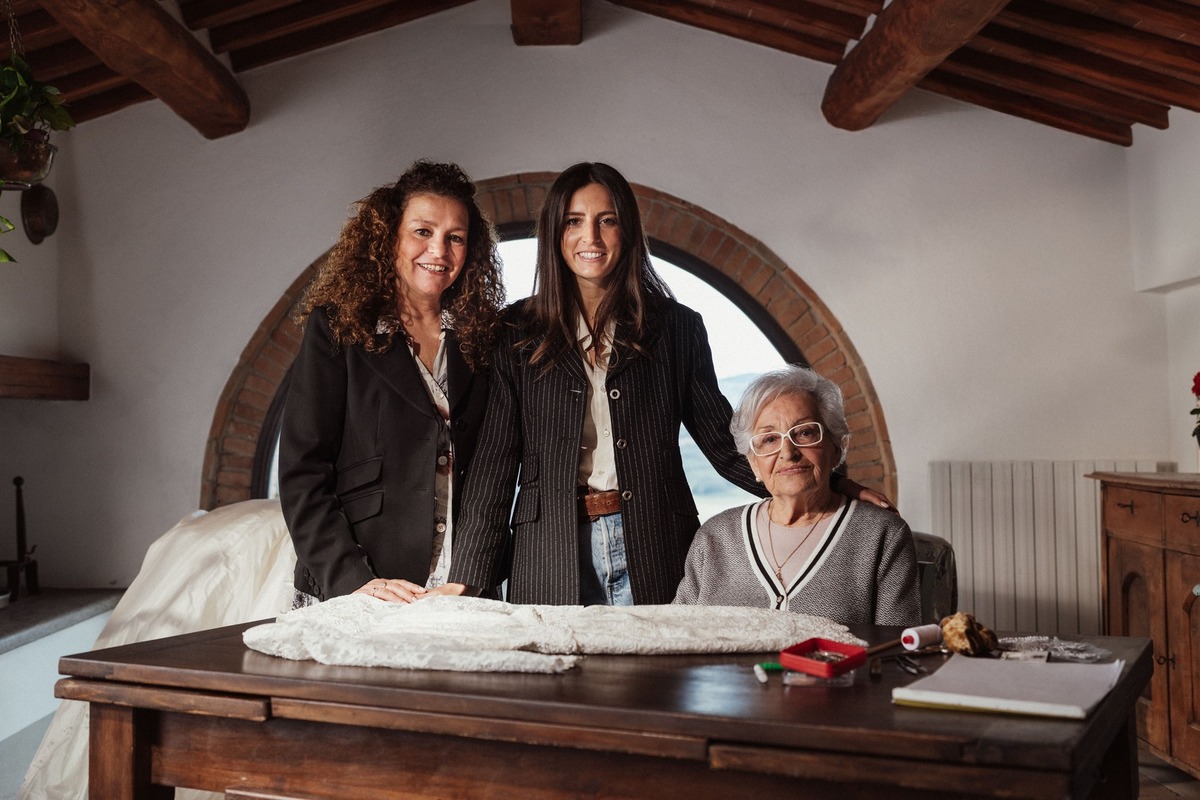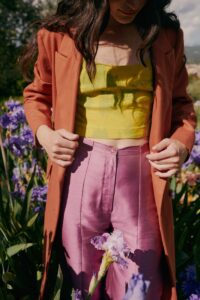By Gaia Rialti
Menabòh and the new paradigm of creative circularity.
In recent decades, fashion has shifted from a form of self-expression to a finely tuned machine of consumption. Production has skyrocketed—over the past fifteen years, the number of garments made each year has more than doubled, while their average use has sharply declined. Today, over 80% of clothes bought are rarely or never worn, and the average person throws away more than 11 kilograms of textile waste annually.
 This is the outcome of the classic “take-make-waste” model: extract finite resources, produce at scale, dispose early. The result? One of the most polluting industries on the planet—responsible for up to 10% of global CO₂ emissions and a key player in systemic overproduction. Each year, millions of unsold garments are dumped or incinerated. But it’s not just the planet paying the price. The fashion supply chain is often riddled with exploitation, instability, and unsafe working conditions.
This is the outcome of the classic “take-make-waste” model: extract finite resources, produce at scale, dispose early. The result? One of the most polluting industries on the planet—responsible for up to 10% of global CO₂ emissions and a key player in systemic overproduction. Each year, millions of unsold garments are dumped or incinerated. But it’s not just the planet paying the price. The fashion supply chain is often riddled with exploitation, instability, and unsafe working conditions.
And yet, amid the cracks in this system, a new awareness is emerging—one that seeks to restore the true meaning of what it means to dress.
In the broader sustainability conversation, fashion has often leaned on surface-level fixes: “green” collections, recycled materials, campaigns showcasing positive impact. But today, more than a cosmetic upgrade, what we need is a structural shift. A new way of seeing – less about volume, more about value; less about consumption, more about identity.
A growing number of consumers, especially younger ones, are no longer chasing trends. They want clothing that tells a story. The new luxury is personal, intimate—it’s about garments that last, that carry emotional weight and artistic expression.
This is where Menabòh comes in: a platform that challenges the traditional fashion system and offers a bold alternative—breathing new life into existing garments through meaningful upcycling, transforming them into one-of-a-kind pieces.
Menabòh: Transform, Don’t Produce
Menabòh isn’t a fashion brand in the conventional sense. It doesn’t create seasonal collections. It doesn’t mass-produce. It doesn’t follow trends. It’s a platform, a creative community, a widespread tailoring service. But most importantly, it’s a belief: that every garment, even the most forgotten, holds potential for transformation—and a story worth telling.
 The process is simple: users choose a designer from a curated network, upload a photo of the piece they want to transform, and share their vision. Within days, they receive a tailored proposal. If they accept, they ship the garment—and soon after, receive a reimagined version of their original piece. A piece that is still that garment, but now with new meaning, new shape, new life.
The process is simple: users choose a designer from a curated network, upload a photo of the piece they want to transform, and share their vision. Within days, they receive a tailored proposal. If they accept, they ship the garment—and soon after, receive a reimagined version of their original piece. A piece that is still that garment, but now with new meaning, new shape, new life.
Some of the stories born through Menabòh reveal just how emotionally powerful this creative process can be:
Francisco: A Pair of Pants, a statement
Francisco is an artist and performer. For him, clothing is an extension of identity. In his wardrobe was a pair of black leather pants that once marked a bold, rebellious chapter of his life—but over time, they had become restrictive, no longer reflecting who he is. Letting them go, however, was not an option.
He came to Menabòh with a clear vision: to transform those pants into something that expressed his current, freer self. The designer he worked with proposed a painted intervention directly on the garment—resulting in a reinterpretation of Caravaggio’s Medusa, infused with drag aesthetics: sensual, fierce, unapologetic. The pants were no longer just pants—they became a manifesto. A wearable work of art. A new language of style and self.
Vittorio: A Father’s Memory, a future vision
Vittorio studies Fashion Design. His wardrobe is full of fabrics, ideas, and experimentation. But there was one item he couldn’t quite place: a vintage velvet jacket that belonged to his father. Beautiful, but outdated in its cut.
 Through Menabòh, he entered a co-creation process. He chose a designer, shared the story behind the jacket, and together they reimagined it—modernizing the shape, softening the shoulders, and adding custom denim inserts selected by Vittorio himself. Today, the jacket bridges past and present. It’s a piece that carries both memory and style—a renewed legacy, worn with pride.
Through Menabòh, he entered a co-creation process. He chose a designer, shared the story behind the jacket, and together they reimagined it—modernizing the shape, softening the shoulders, and adding custom denim inserts selected by Vittorio himself. Today, the jacket bridges past and present. It’s a piece that carries both memory and style—a renewed legacy, worn with pride.
Cristina: Streetwear with Soul
Cristina has always loved streetwear. For her, clothes are daily declarations of independence and creativity. Still, buried in her wardrobe was a hoodie gifted years ago—emotionally significant, but no longer her taste.
Instead of discarding it, she chose transformation. With the help of Menabòh’s designers, she created a fully customized piece: recycled fabrics were layered into a vibrant collage, and the fit was reshaped to be more contemporary. The result? A unique statement piece, fully aligned with her identity, and rich with personal meaning. Proof that upcycling can be not just sustainable—but deeply expressive.
Paola: Wearing a memory
For Paola, clothing holds deep emotional value. After losing her mother, she was left with several of her garments. Keeping them in the closet mattered—but it wasn’t enough. She wanted to make them part of her everyday life.
With Menabòh, she selected a few special items and entrusted them to the transformation process. Each redesign was approached with care—preserving the soul of the garment while reinterpreting its form. A shirt, a coat, a pair of pants: each became a small, intimate ceremony. Today, Paola doesn’t just wear those clothes—she shares a living dialogue with them. As if each stitch were a memory made visible.
A new way to think about your wardrobe
Menabòh isn’t just about creating unique garments—it’s about cultural change. In Italy, where upcycling is still a relatively unfamiliar concept, the challenge is to prove that being stylish can start in your own wardrobe. That transformation doesn’t always mean buying something new.
Changing consumption habits isn’t easy. We’re wired for instant gratification—for the thrill of a fresh purchase. But now more than ever, it’s time to see our clothes differently. To realize that every piece we already own can be a beginning—not an end.
Menabòh wants to be the go-to platform for this shift. A new culture of dressing—where fashion becomes art, identity, and care once again. Where clothing isn’t just consumption, but connection. With ourselves, with memory, with the planet.
Valley Life invites you to explore how you can rewrite your wardrobe and express your identity in the process. Visit www.menaboh.com. Every garment has a story. What story will you tell?

